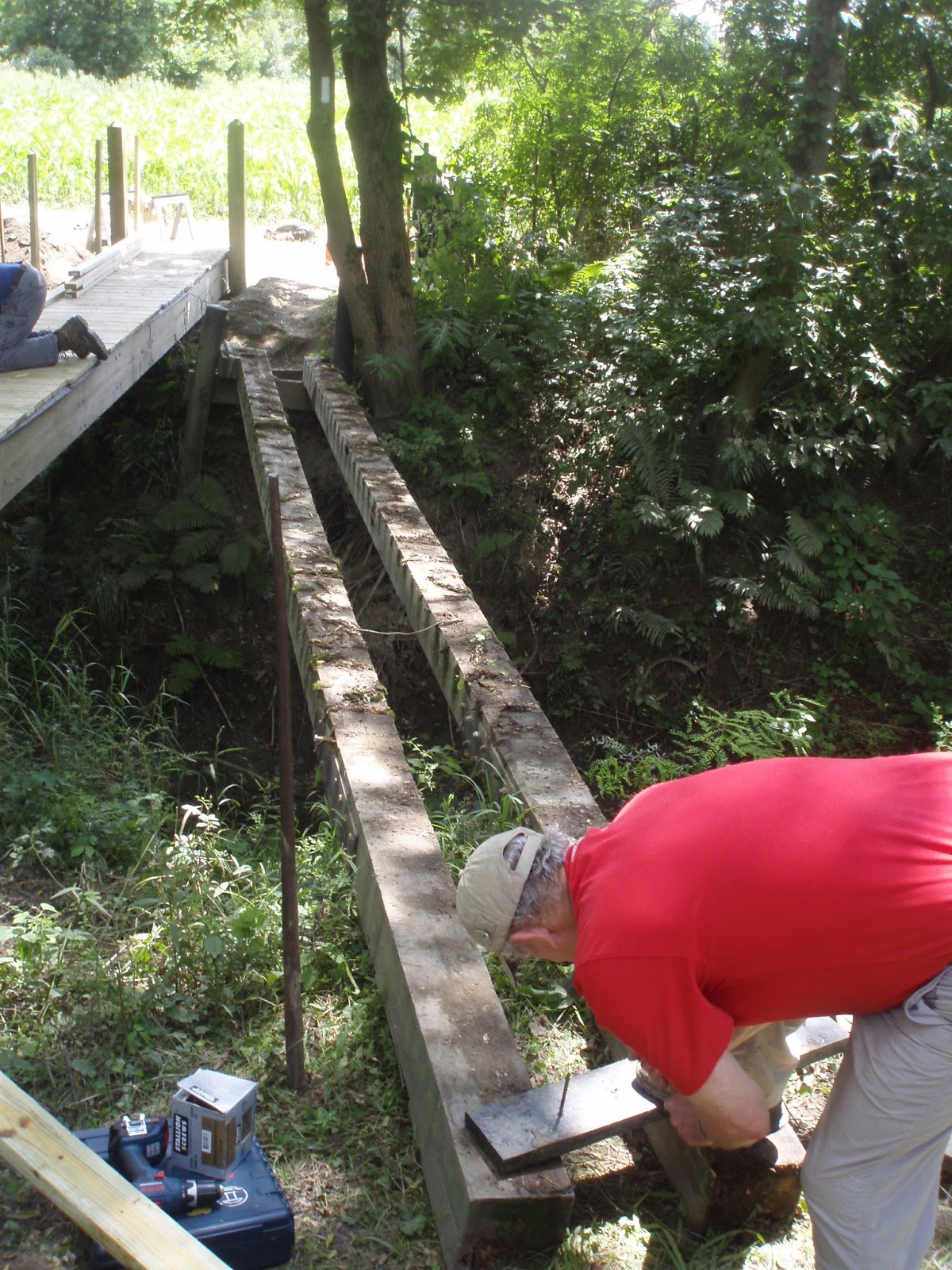Rt 7 Bridge--Completed
August 3rd, 2013
With an experienced crew of 8 bridge builders we wrapped up the project today.
 |
| Pete and Christine start planking on the south end |
We arrived on site to find the timbers as we had left them spanning the stream. We attached them to the sills and began to install the blocking and deck planks. Because the beams were slightly warped, we used a bar clamp to align them as we inserted the blocking in the space between the beams.
 |
| Dave and Steve start on the north |
This blocking serves several functions: it helps share the load among all three timbers, maintains equal space between them and most importantly, because the beams are relatively narrow for their depth, keeps them from twisting under load.
The careful layout and installation of joist hangers on previous project days paid off, as we had little trouble inserting the blocking.
 |
| Kneeling on temporary planking, Pete and Dave drive the "golden spike" in the middle of the span |
 |
| The bridge seems strong enough |
While the blocking and planks were being installed, four 6x6 posts were set into the ground, two at each end of the bridge. These are intended to keep the bridge mostly in place should it ever be floated off the ground by flood waters. This area sees water up to two feet above the trail--particularly in the spring. When this happens, hikers are routed onto adjacent roads until the water subsides, usually in a day or two.
Our greatest concern would be to find the bridge had been floated so far out of location that one end dropped into the stream--the thing is so heavy we would not likely be able to pull it back into place w/o heavy equipment.
 |
| Bob and Don attach railing posts |
Adding railings to the bridge completed this phase of the project.
While most AT bridges in Mass don't have railings, for this long span and deep ravine, railings seemed like an appropriate measure.
 |
| Our first official customers. Two Northbound thruhikers |
The final phase was the demolition and removal of the old bridge. Using a rock bar, we were able to easily pry the planks from the the 8x8 timbers.
 |
| Steve removes nails from the old bridge planks |
Timbers were unbolted from their posts on the north end and using the comealong--with some effort--we were able to drag them over to the south bank. The timbers were cut in half for transport back to the tool shed.
 |
| Don operates the comealong to drag the old timbers ashore |
We then cut up the portions that were not rotting, and will use them for bog bridge base timbers on a project happening later in the month.
From identifying the problems with the old bridge (rotting support beams and a widening stream bank), to completion this past week took almost two years. Along the way, we were early users of ATC's new bridge policy, applied for and received approvals from the Sheffield Conservation Commission and the National Park Service, and paid for about half the materials through an LL Bean Grants to Clubs program. Total cost for this project was about $2000. Volunteer hours for construction totaled 138. Planning hours are harder to figure, but are probably around 100. During construction, we had the pleasure of working with staff from ATC's New England Regional Office and the Mass Department of Conservation and Recreation's AT Ridgerunners. Special thanks to Bruno's Dog House for letting us use their hose to wash off with poison ivy soap after each day of construction.
 |
| Open for business. Note the posts at the ends to reduce the tendency for the bridge to float away |
 |
| Looking Northbound |










No comments:
Post a Comment